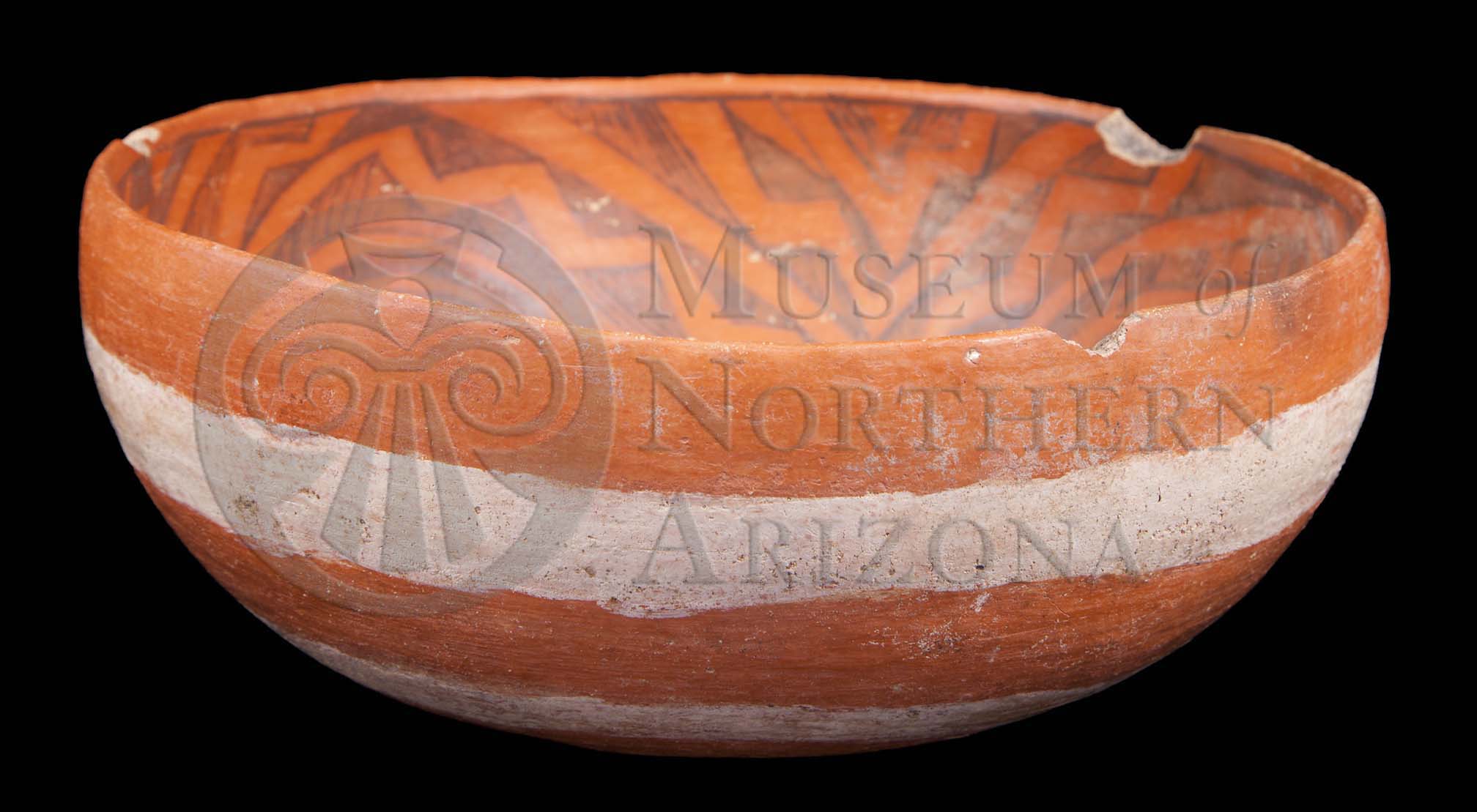
St Johns Polychrome bowl from the Museum of Northern Arizona collections. Click the image to open the White Mountain Red Ware gallery.
White Mountain Red Ware is a pottery ware found made in northeastern Arizona and northwestern New Mexico. The full geographical range of this ware is from the Zuni Indian Reservation in west-central New Mexico to Chaco Canyon, and in east-central Arizona from Springerville north to Ganado and west along the Mogollon Rim to the Sierra Ancha and Tonto Basin. As a trade ware, White Mountain Red Ware has also been reported in locations from Casas Grandes, Chihuahua, Mexico to Mesa Verde, Colorado, and from Casa Grande, Arizona to Kwaituki Pueblo on Orabi Wash, fourteen miles north of Orabi Pueblo on the Hopi Reservation.
Types found in the American Southwest Virtual Museum collections include: Fourmile Polychrome, Pinedale Black-on-red (image gallery only), Showlow Polychrome, and St Johns Polychrome.
Archaeological Culture: Ancestral Puebloan
Date Range: Pre-A.D. 1200 to post-1400.
Construction: By coiling.
Firing: In an oxidizing atmosphere.
Core Color: Gray, black, cream, buff, pink, orange, brownish to brick red.
Carbon Streak: Occasional.
Temper: Light colored angular fragments, mostly medium fine of fairly uniform size, usually grayish in reduced, yellowish in oxidized portions; sometimes black, red, or pinkish fragments; quartz sand grains rare or absent, except in Fourmile Polychrome and Showlow Polychrome; temper usually conspicuous in cross-section and on worn surfaces; not conspicuous through slip.
Surface Finish: Bowls always slipped on both surfaces, except Houck Polychrome and Wingate Corrugated (which are slipped only on the interior); jars always slipped on the exterior (only); slip usually heavy, usually well-polished, frequently powdery, occasionally flakes, occasionally crazed; sometimes slightly bumpy. Wingate Corrugated not smoothed.
Surface Color: Red, pinkish, brownish, buff, cream (Querino Polychrome, exterior), orange, light yellow, rarely slate gray in part (Klageto Black-on-yellow, sometimes), in part white (some types); color core and surface color generally contrast.
Forms: Bowls (predominate) and jars.
Vessel Thickness: 2.8 to 8.2 mm.
Decoration:
- Paint: Black, white, red; black usually glaze, sometimes gritty, sometimes vitreous, occasionally weak and watery.
- Pigments: Usually copper, lead, and some manganese; occasionally iron-carbon when non-glaze; white pigment, usually somewhat chalky and fugitive, presumably kaolin; red pigment dull, thin, and watery, sometimes thick, almost like slip, probably hematite.
- Design: Bowl interiors, usually black paint on red slip, sometimes black and black-and-red on white slip, sometimes black-and-white on red slip; exteriors, usually black, white or black-and-white on a red slip, sometimes black on white slip; jar exteriors same as bowl interiors.
Comparisons: San Juan Red Ware, surface never cream; carbon streak common; surface color and core rarely contrast; temper, about equal amounts of opaque angular fragments and quartz sand, conspicuous through slip in some types; mica like flakes fairly frequent in some types; slip always red when present, several types unslipped; jars fairly frequent, predominant in one type; black paint always non-glaze.
Other Names: Red Ware, Little Colorado Ware, Little Colorado Red Ware.
Compiled from the following sources:
Carlson, Roy. (1970) White Mountain Redware: A Pottery Tradition of East Central Arizona and Western New Mexico. Anthropological Papers of the University of Arizona, No. 19. Tucson.
Colton, Harold S., and Lyndon L. Hargrave. (1937) Handbook of Northern Arizona Pottery Wares. Museum of Northern Arizona Bulletin 11, Flagstaff, Arizona.
Compiled by:
April Peters, Northern Arizona University Anthropology Laboratories.
